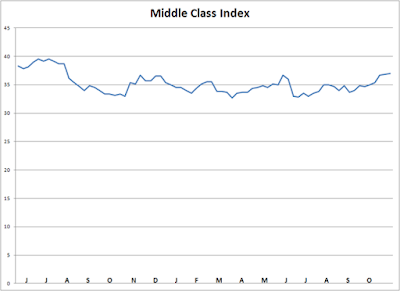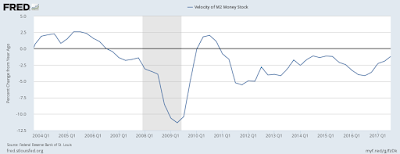Gold’s Silent Comeback And The Middle Class Rebound
The middle class has been stuck in a rut – psychologically if not economically – for years, and they’re not afraid to admit it. Last year’s upset victory for Donald Trump in the U.S. presidential race was a manifest token of middle class angst.Opinion polls have shown that many of the anxieties expressed by the middle class last year are still a concern for them this year. In other words, not much has changed since a year ago. There are some strong indications that the middle class outlook will change for the better in the coming months, however, as we’ll discuss in this commentary.
Ask the typical middle class wage earner if they think their economic prospects will improve in the year ahead, however, and you’ll likely receive a cynical response. If there was any doubt that Middle America’s economic prospects haven’t improved much since last year, the following graph will lay them to rest. Shown here is the Middle Class Index (M.C.I.), a share price composite of several leading companies that cater to a largely middle class customer base.The components of this index include JC Penny (JCP), Ford (F), Dollar General (DG), Wendy’s (WEN), Wal-Mart (WMT), and Kroger (KR).
(Click on image to enlarge)

If the above graph is any indication of middle class consumption patterns, then middle income Americans haven’t exactly set the world on fire with their spending. The implication of the M.C.I. is that while middle class spending has certainly increased over the last several years, it has essentially flat-lined on a 3-year basis.While there is admittedly a danger in reading too much into such a simplified overview of middle class spending, it’s likely not far from the truth to assume that middle class Americans aren’t making much progress. At least, that’s how they feel based on the trend of the Middle Class Index.
So the question is, “Will the economic prospects ever improve for the middle class?” While many would respond with a bleak “Never!” there is actually a good indication that the year ahead will witness some solid improvement. Consider the next chart exhibit, which highlights the prospects for the upper middle class (i.e. individuals who earn in excess of $75K/year). The Upper Middle Class Index shown here is a stock price average of several companies which cater mainly to the upper middle, including Target (TGT), Starbucks (SBUX), BMW (BMWYY), Apple (AAPL), and Ruth’s Chris (RUTH).
(Click on image to enlarge)

What this graph suggests is that, in contrast to the middle class, upper middle class consumers have increased their spending over the last year. In just the last few months alone the Upper Middle Class Index has trended decisively higher as luxury spending among upper middle and upper income consumers has been buoyant. The message of this indicator is that the upper middle class is in much better shape than the middle class.
There is another takeaway from our discussion of the Upper Middle Class Index, however. Historically, economic improvement following a major downturn like the last recession proceeds from the highest economic classes to the lowest. It’s much like a freight train when it starts rolling from a standstill; the engine moves first, then the cars closest to the engines, and so on until at last the final cars begin moving forward. The upper class is always the first to benefit from an increase in credit and money supply, then the upper middle, then the middle, and finally the lower class. Like a train, economic momentum takes time to build up but when it finally becomes established it tends to be self-sustaining.
The fact that the Upper Middle Class Index is increasing is a positive indication for the middle class, for it suggests that the increased spending patterns of the upper class of recent years have finally spilled over into the upper middle class. Eventually the middle class will eventually follow the lead of the upper middle, as is always the case.
One sign that the U.S. economy may be on the cusp of truly breaking out is found in the graph illustrating the rate of change in M2 money velocity. This is one way of measuring the demand for money. Money demand, as measured by the ratio of M2 money stock to nominal GDP, has been extremely high by historical standards for the last several years. In fact, the demand for cash has been extraordinary since the 2008 crash, as investors have feared a recurrence of the crisis years.The inverse of this measure is the velocity of M2 money (nominal GDP divided by M2). Velocity remains near multi-decade lows in reflection of the public’s massive demand for cash; however, it shows signs that it may be reversing.
The following graph, courtesy of the St. Louis Fed, shows the year-over-year change in M2 money stock. As you can see, it’s trending gradually higher and is close to entering positive territory for the first time since Q1 2010, when the combined impact of Federal Reserve and U.S. government stimulus was at its highest following the Great Recession. This is also a sign that the perennial problem of low inflation is gradually reversing as inflation slowly, almost imperceptibly, makes its return.
(Click on image to enlarge)

Another indication that things are about to improve for the middle class is, perhaps surprisingly, the price of gold. Gold serves two primary functions in today’s economy. The first is as a reflection of how much fear exists among investors as it pertains to the future outlook. The gold price is basically one way of gauging how much confidence stakeholders (producers, consumers, and investors) have in the future prospects for business.
More than this, gold is also a measure of future inflation expectations. When the economy was still quite fragile between the years 2009 and 2011, investors placed a high premium on gold ownership as reflected in runaway gold prices. When it became clear in late 2011, however, that the U.S. recovery was gaining traction, gold lost much of its luster as a safe haven and it became less desirable for investors to commit the bulk of their investment capital to it. Risk assets instead became more attractive, undermining the demand for gold.
Since last year, however, gold has embarked on a “silent comeback,” effectively ending a four-year bear market.(See the SPDR Gold Shares ETF chart below for illustration.) It has been consolidating its gains in recent months as it prepares to continue its long-term rebound. The going has been slow for the most part, mainly because inflation has been slow to return and equities continue to steal some of the yellow metal’s thunder.If the M2 velocity chart shown above is any indication, however, then inflation should slowly increase in the coming years. This would certainly brighten gold’s longer-term prospects and make gold ownership more attractive to the average investor once again. A moderate amount of inflation, besides boosting gold’s lure, would also help the middle class to recover even more.
(Click on image to enlarge)

In the final analysis, a full-fledged middle class economic revival has been talked about and anticipated for years, and its failure to arrive has been frustrating.Its manifestation is long overdue, however, and while it has been slow in coming the indicators discussed here bode well for the middle class in the months ahead. History shows that sustained improvement in the upper middle class always eventually spills over to the next level down, which is good news for Middle America in 2018.
Disclosure: None.



